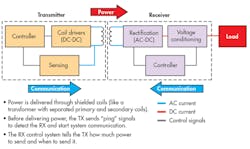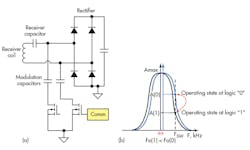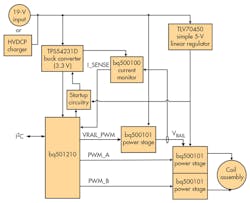Wireless Charging Wades into the Industrial Environment
Download this article in .PDF format
Wireless charging, also called wireless power transfer (WPT), is widely used in portable and wearable consumer devices such as smartphones, fitness bands, shavers, and electric toothbrushes. However, it has advantages for industrial applications, too. Industrial applications include electric vehicles, drones, factory automation, handheld terminals, contactless charging of subsea vehicles, and much more.
Why wireless? Portable equipment in an industrial setting often must operate in a harsh environment, where exposure to moisture, dust, dirt, oil, and other contaminants is an everyday occurrence. With no power connectors to worry about, a wireless-charging system can be made impervious to stray liquids, dust, or gases.
Another advantage: There’s no danger of an explosion caused by a stray spark when connecting or disconnecting a current-carrying power cable.
Wireless Power Standards
The most popular wireless-charging technology uses near-field charging (NFC), in which a transmitting coil produces a magnetic field that transfers inductive energy to a nearby receiving coil. A fraction of the magnetic flux generated by the primary transmitter coil penetrates the secondary receiver coil and thus transfers power—the two coils essentially form a transformer.
The transfer efficiency depends on the coupling (k) between the coils and their quality factor (Q). A tightly coupled system gives the most efficient power transfer, but is highly sensitive to both the misalignment of the coils and the distance between them.
There are two competing NFC standards. The Wireless Power Consortium (WPC) controls the Qi (“Chee”) standard which has an operating frequency of 100 to 200 kHz; the AirFuel Alliance, formerly known as the Power Matters Alliance (PMA), supports AirFuel Inductive, operating at 100 to 350 kHz. Both systems achieve an overall efficiency of >70%
Many manufacturers support both standards. Samsung, for example, includes both Qi and AirFuel charging in its Galaxy S6 and S7 smartphones
Wireless charging is a fast-moving field, For example, Qi has gone through several revisions, as shown in the table.
The WPC has issued several iterations of its popular Qi standard, increasing output power and adding bidirectional communication (FOD = foreign object detection). (Source: Texas Instruments)
One of the drawbacks of wireless power charging compared to a wired system is the relatively long charging time. To solve that problem, manufacturers are increasing power levels. WPC v1.2, introduced in 2015, can deliver up to 15 W. This is defined as “medium power” by WPC, in contrast to the “low-power” 5 W of earlier revisions.
Why pick a standards-compliant design? Compliance guarantees that transmitters and receivers with different power levels, or devices from different manufacturers, will seamlessly operate together. This convenience isn’t free, though: The OEM must spend the money to join the consortium, then test and certify its components.
Some OEMs might opt for a proprietary design to accommodate specific requirements, such as a custom form factor. A proprietary design may offer more flexibility, but it also incurs added risk since the OEM is responsible for all aspects of the transmitter and receiver design, including safety certification.
Wireless-Charging Architecture
Regardless of the standard adopted, an inductive wireless system consists of two parts: a charging station or pad containing the transmitter circuitry and primary coil; and the device being charged, which contains the secondary coil and its associated circuits.
During operation, the transmitter is in a low-power “snooze” mode most of the time and wakes up periodically to check whether a receiver is present. If it detects the presence of a secondary coil, the transmitter requests authentication from the receiver. After a successful authentication the transmitter initiates charging; otherwise, it goes back to sleep (Fig. 1). The secondary side maintains full control over the power transfer using communication packets.
Coil Design
The WPC standard requires the designer to choose a transmitter coil that meets precise specifications for the desired input voltage: 5 V, 12 V, or 19 V. The A5 coil, for example, is a 5-V, 6.3-µH coil with 10 turns of wire, a circular cross-section, and a magnet in the center (Fig. 2). Newer designs are moving to the A11 coil, a very similar design without the magnet. A multi-coil solution such as the A6 increases the available charging area, but increases the BOM (bill of materials) cost because it requires a separate driver for each coil.
2. These Qi-compatible 10-turn transmitter coils are made from silk-covered wire with a ferrite base. (Source: Hartai Technology)
Transmitter and receiver coils are typically constructed from Litz wire; this consists of many insulated strands wound in a specific pattern to minimize the skin effect and reduce proximity losses. For higher power levels, the coil is mounted on a sheet of ferrite. A manufacturer of transmitters and receivers often publishes a list of recommended coils for use with its products.
For maximum coupling, the receiver and transmitter coils should be similar in size. The receiver coil tends to be more complex—it must be very thin, yet withstand vibration, shock, and all of the other indignities suffered by a portable or wearable device. One example from Würth Electronik consists of five layers: first is the Litz wire coil, closest to the transmitter, followed by adhesive tape, a layer of PET (polyethylene terephalate) plastic for shock resistance, the ferrite sheet, and finally, another adhesive layer to attach the assembly to the rest of the unit.
WPT Communication
The receiver (secondary) side controls the amount of power transferred by the transmitter (primary) drive. The secondary communicates with the primary by changing the load seen by the primary.
Two options are available. A resistive load change changes the amplitude of the transmitter voltage; a capacitive load change gives a time displacement (Fig. 3).
3. Switching in a capacitive load represents one method of receiver-to-transmitter communication (a). The effect is to displace the position of the maximum amplitude about the null position (b). (Source: Texas Instruments)
The communication scheme is digital, with packets being transferred from the secondary to the primary. The Qi standard specifies a data rate of 2 kb/s with biphase bit encoding. A variety of communication packets have been defined for functions such as identification and authentication; error detection; control; power usage; end of power; and efficiency.
Foreign Object Detection (FOD)
Any metal object, such as a key or a coin, that comes between the primary and secondary coils can absorb a portion of the electromagnetic field. This reduces the efficiency of the power transfer; the object can also heat up and pose a safety hazard.
An inductive WPC system detects a foreign object by comparing the power received at the receiver with the power sent from the transmitter and looking for power loss. If the power loss exceeds a preset threshold, the transmitter reduces power or shuts down completely and sets an error flag.
So-called “friendly metals,” such as the metal parts of a smartphone, may also absorb power. Therefore, each different use case must be calibrated before production to determine a normal level of power loss.
FOD is required by WPC specification v1.1 and later.
WPT Design: Transmitter
Figure 4 shows a more detailed block diagram of the transmitter section in a WPC v1.2-compliant system. The heart of the design is the bq501210, a wireless power digital controller that can deliver up to 15 W to a suitable receiver. The controller periodically pings the surrounding environment for available devices to be powered, performs FOD, monitors all communication from the receiver, and adjusts transmitted power based on feedback received. It also manages the fault conditions associated with the power transfer and controls the operating-mode status indicator.
4. This WPC v1.2-compliant transmitter design uses an A5 coil and can provide up to 15 W from a 19-V supply. (Source: Texas Instruments)
The bq501210 controls the transmitted power by varying the coil voltage VRAIL, while maintaining a constant 130-kHz frequency and 50% duty cycle. To accomplish this, the bq501210 drives a bq500101 dual NexFET power stage with PWM output VRAIL_PWM. The filtered output is a dc voltage proportional to the PWM frequency and provides VRAIL. PWM_A and PWM_B then drive a full-bridge circuit composed of two additional bq500101s. The full bridge configuration maximizes the power delivered to the A5 coil for a given supply voltage.
For 15-W operation, the input voltage must be a regulated 15- to 19-V source that can deliver 2-A continuous load current. If the system supports High Voltage Dedicated Charging Port (HVDCP) technology, and the input voltage is less than 6 V at startup, the bq501210 negotiates for higher input voltage. If the receiver device supports Fast Charge operation, the bq501210 can negotiate to provide extra power for rapid charging.
For FOD use, a WPC 1.2-compliant bq500100 high-side current sensor measures the voltage drop across a shunt resistor in the VRAIL line and feeds the result back to the bq510210. To supply power to the various components, the design also uses a TLV70450 low-dropout (LDO) regulator for 5 V and a TPS54231 buck converter for 3.3 V.
WPT Design: Receiver
The receiver’s function is to receive the power from the transmitter, rectify and regulate it, then transfer it to the load. Figure 5 shows a receiver design based around the bq51025, a device that provides single-chip power conversion as well as digital control and communication compliant with WPC v1.1.
The design can transfer up to 10 W when operating with the bq501210-based primary-side controller discussed earlier. For a 10-W application, the design makes use of TI’s proprietary protocol to provide bidirectional communication, which isn’t supported by WPC v1.1.
5. This single-chip WPC v1.1 receiver design outputs 7 V at 1.4-A maximum current. (Source: Texas Instruments)
The bq51025 features adjustable output voltage of 4.5 to 10 V, and enables a system efficiency of up to 84%. The I2C interface allows for easy interfacing to a low-power microcontroller, such as one of TI’s MSP430 family.
If compatibility with multiple wireless standards is a requirement, the bq51222 wireless receiver offers 5-W output power and compliance with both the WPC v1.2 and AirFuel communication protocols.
Conclusion: WPT and Industry 4.0
Industrial users already employ wireless charging in their tablets, point-of-sale terminals, inventory control scanners, etc., but Industry 4.0 represents another huge opportunity.
In the highly automated connected factory of the future, autonomous vehicles, drones, and mobile robots will replace many human workers, a process that’s already well underway. This represents a great opportunity for wireless charging since autonomy implies battery power. This, in turn, requires multiple recharging pads and mats to which vehicles can return to top up their batteries without human intervention.
Many industrial applications will demand a higher-power solution than the 15-W designs discussed in this article. Whether the solution will be provided by a version of the Qi or AirFuel standards, a proprietary approach, or a combination of all three, remains to be seen. The design techniques discussed above, though, will undoubtedly play a key role in expanding the use of wireless power charging in the industrial environment.







